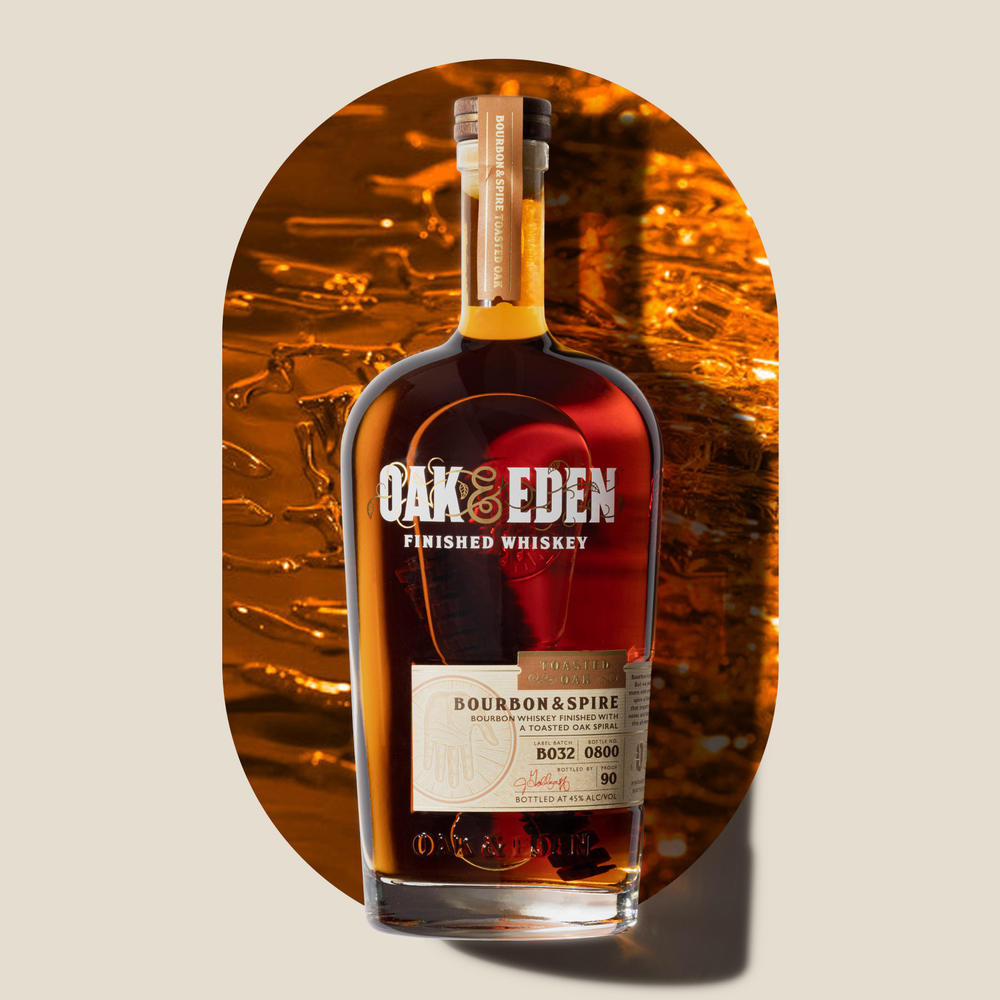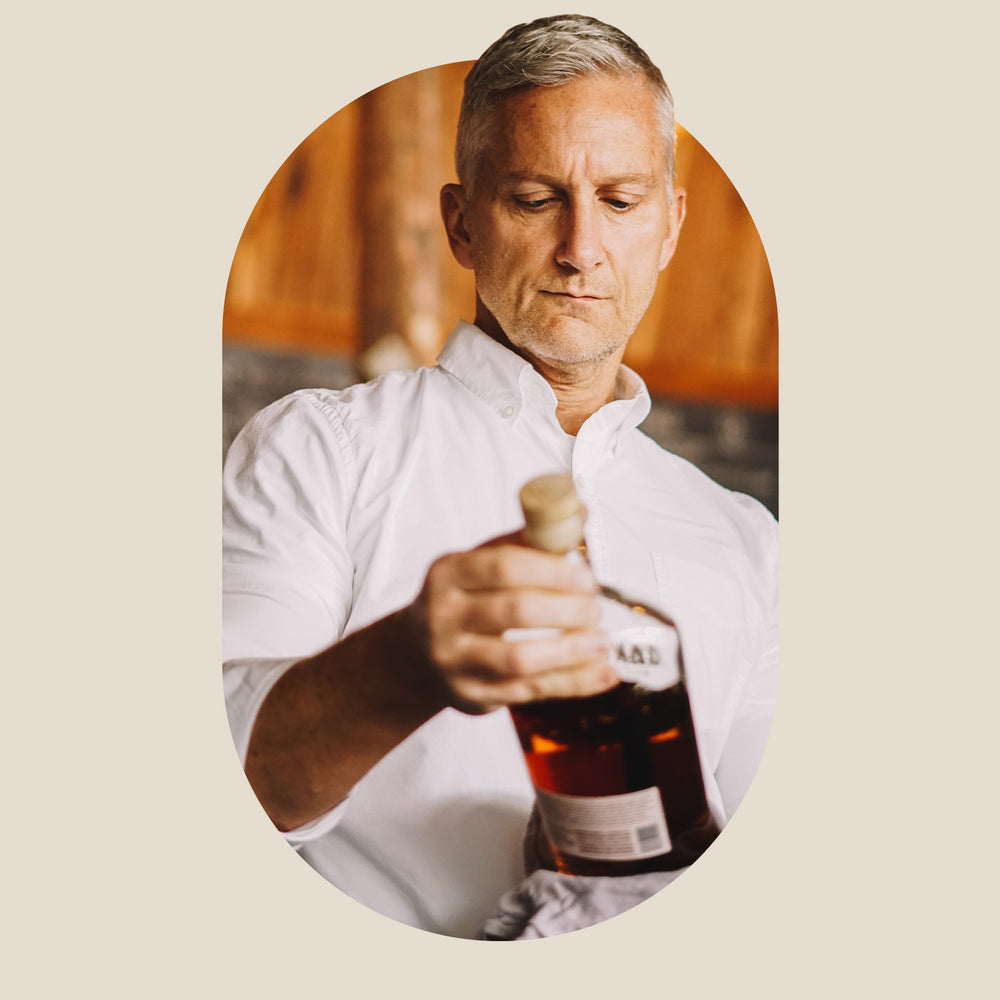
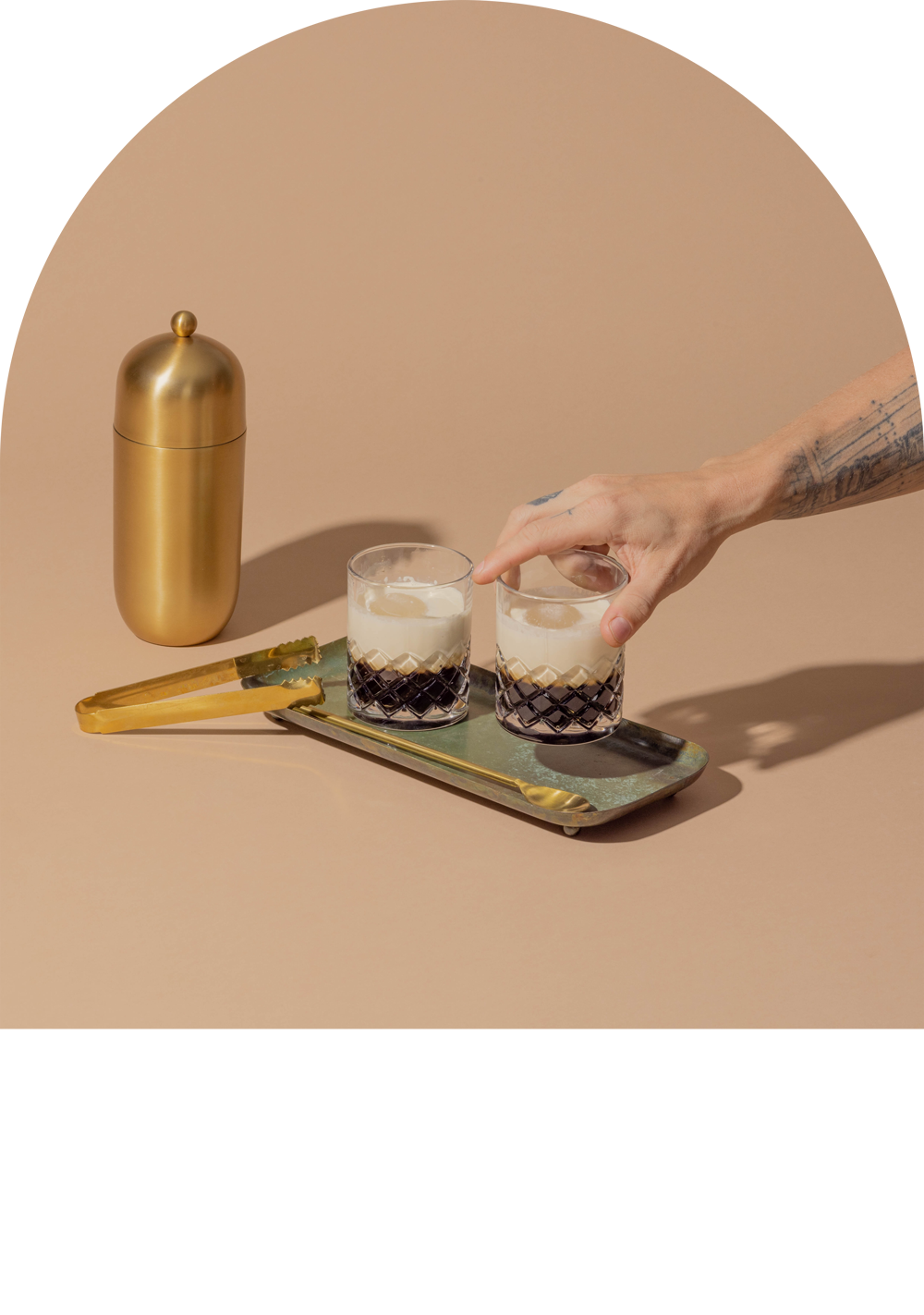
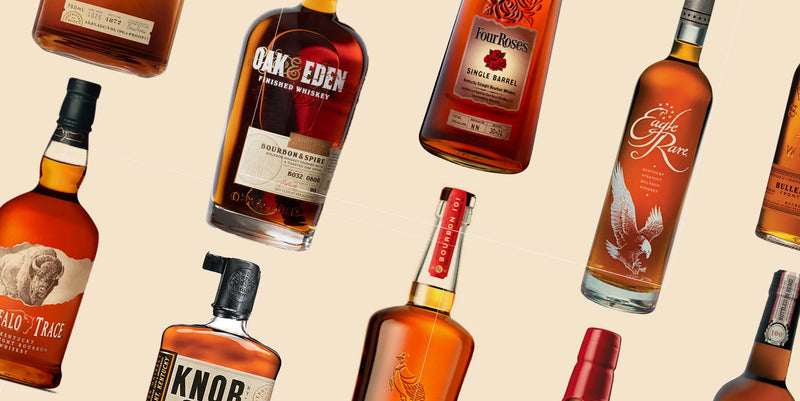
TOP 10 BOURBONS FOR THE BEST OLD FASHIONED
Creating the perfect Old Fashioned cocktail starts with selecting the right bourbon. The bourbon not only serves as the foundation but also influences the cocktail's overall flavor profile. Here's a list of the top 10 bourbons that are highly recommended for crafting the best Old Fashioned:
Buffalo Trace
A versatile favorite known for its balanced sweetness and notes of vanilla and caramel, making it an excellent base for an Old Fashioned.
Woodford Reserve
This high-proof bourbon offers rich flavors of dried fruits and spices, contributing to a complex and robust cocktail.
Oak & Eden Bourbon & Spire
Innovative with its in-bottle spire that continues to infuse flavors over time, this bourbon evolves, adding a unique dynamic to each drink.
Knob Creek
At 100 proof, Knob Creek provides the strength needed to stand up to the dilution of ice, adding depth with its woody and rich caramel notes.
Bulleit Bourbon
Popular for its high rye content, Bulleit adds a spicy kick to the Old Fashioned, complemented by sweet tones of maple and oak.
Four Roses Single Barrel
Known for its floral aroma and flavors of ripe plum and cherries, it brings a unique and flavorful twist to the traditional cocktail.
Maker’s Mark
With its softer flavor profile featuring sweet, creamy caramel and vanilla, Maker’s Mark creates a smoother, milder Old Fashioned.
Wild Turkey 101
This bourbon stands out with its high proof and bold flavors, including notes of honey, butter, and a hint of orange, which add a vibrant kick to the cocktail.
Eagle Rare
This bourbon offers a complex array of flavors with hints of toffee, honey, and toasted oak, making for a sophisticated Old Fashioned.
Rittenhouse Rye
While not a bourbon, Rittenhouse Rye deserves mention for its robust and spicy profile that makes a bold, flavorful Old Fashioned.
READ THE STORY
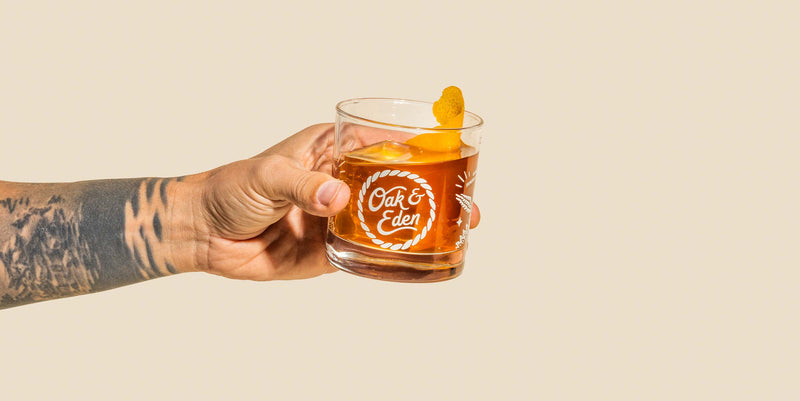
BEST BOURBON FOR AN OLD FASHIONED
When it comes to crafting the quintessential Old Fashioned, the choice of bourbon is not just a detail—it's the foundation of this storied cocktail. While Oak & Eden proudly offers a range of whiskeys that can enhance any cocktail, it's important to explore what characteristics make a bourbon ideal for an Old Fashioned. This discussion will also touch on why rye whiskey is a notable contender for those who appreciate a spicier, more robust version of this classic drink.
Understanding the Profile of an Ideal Bourbon
The Old Fashioned is a cocktail that relies heavily on the whiskey used, as it's combined with only a few simple ingredients—sugar, bitters, and water. This minimalism means the chosen bourbon's flavor profile significantly influences the drink's final taste. Here are several key qualities to consider when selecting a bourbon for an Old Fashioned:
1. Rich Flavor with Balanced Sweetness
The bourbon should have a noticeable depth of flavor, with a pleasing balance of sweetness. Caramel and vanilla notes, typical of many bourbons due to the charred oak aging process, contribute to a richer, smoother Old Fashioned.
2. High Proof
A higher-proof bourbon, typically around 90-100 proof, is often recommended. The higher alcohol content ensures that the bourbon's robust flavors can stand up to dilution from the ice and integration with the sugar and bitters. This doesn't mean the strongest bourbon you can find; rather, it should be potent enough to maintain its character in the cocktail.
3. Complexity and Finish
The bourbon should offer complexity and a pleasant finish. Elements like a touch of spice, wood, and fruit undertones can add an intriguing layer to your Old Fashioned, enhancing the overall drinking experience.
Ever Consider Rye Whiskey?
Rye whiskey, which is often spicier and fruitier than bourbon, can also be an excellent choice for an Old Fashioned. Its inherent spice profile complements the sweetness of the cocktail’s sugar and the depth of the bitters, providing a bolder, often more balanced flavor. For those looking to deviate slightly from the norm while maintaining the spirit of the classic cocktail, rye offers an appealing alternative.
Popular Picks
While the perfect bourbon for an Old Fashioned can vary based on personal preference, here are a few commonly preferred choices:
Oak & Eden Bourbon & Spire: This innovative bourbon features a unique twist with a wood spire inserted into the bottle, which continues to impart subtle flavors over time. Its smooth profile enhanced with vanilla and caramel tones from the spire makes it a unique and evolving choice for an Old Fashioned.
Oak & Eden Rye & Spire: For those who prefer a spicier take on their cocktail, Oak & Eden’s Rye & Spire brings a bold flavor profile with its rye spice complemented by the additional complexity from the in-bottle spire. This choice offers a vibrant, peppery twist to the classic cocktail, providing a balanced yet bold flavor.
Buffalo Trace: Known for its rich and complex flavors with vanilla, toffee, and candied fruit, it strikes a nice balance in an Old Fashioned.
Woodford Reserve: Its high proof and flavor notes of dried fruit, spices, and chocolate make it a robust base for the cocktail.
Knob Creek: The 100 proof and rich woodiness stand up well to the dilution and complement the sweetness and bitterness beautifully.
Selecting the right bourbon for an Old Fashioned is about more than just grabbing any bottle from the shelf. It involves understanding the nuances that each type of whiskey brings to the cocktail. Whether you choose a classic bourbon with a smooth finish or a spicy rye, the key is to balance all the ingredients to create a harmonious and delightful experience. At Oak & Eden, we celebrate the craft of whiskey and encourage enthusiasts to explore their tastes, perhaps even with one of our carefully crafted bottles. Cheers to finding your perfect match for the ultimate Old Fashioned.
READ THE STORY
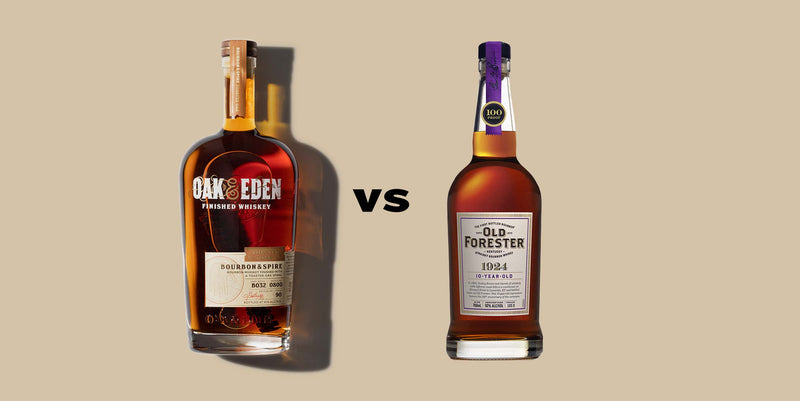
OLD FORESTER 1920 VS OAK & EDEN WHISKEY
At Oak & Eden, we are proud to stand among giants in the whiskey industry, each brand with its own story and method. Today, we draw a comparison between our innovative approach and the classic Old Forester 1920 Prohibition Style, a staple of whiskey lore. This exploration celebrates the heritage embedded in Old Forester's approach, while highlighting the forward-thinking innovation that defines Oak & Eden.
Celebrating Old Forester 1920
Old Forester 1920 Prohibition Style is part of their Whiskey Row Series, designed to honor the distillery's rich history during Prohibition when it was one of the few to be granted a permit to produce medicinal whiskey. This expression is crafted to emulate the style and strength of the bourbon produced by Old Forester at that time, which was known for its robust character. Bottled at 115 proof, it delivers rich, intense flavors of chocolate, caramel, and spice, making it a favorite among enthusiasts seeking depth and complexity.
The Innovation of Oak & Eden
In contrast, Oak & Eden whiskey embodies the spirit of modern craft distillation. Our signature approach involves an in-bottle finishing technique, where a spiral-cut piece of wood, called a "spire," is placed inside each bottle of whiskey. This method is not just a novelty; it introduces an ongoing maturation process within the bottle, allowing the whiskey to evolve and gain additional flavors over time. The result is a dynamic and ever-changing profile that offers a unique experience with each bottle. Our range includes various expressions, each influenced by different wood types and toasting levels, providing a diverse palette that appeals to modern tastes, and even allows our customers to customize their own unique bottle of whiskey.
Flavor Comparison: Complexity vs. Evolution
Old Forester 1920 delivers a classic bourbon experience with its deep, rich flavors that echo the historic roots of American whiskey. It's a nod to the past, perfect for those who appreciate a strong, well-rounded bourbon with a story to tell. The taste is profound, marked by an unmistakable intensity that reflects its high-proof lineage, with notes of chocolate covered graham cracker dusted with cinnamon.
Oak & Eden, however, offers a different journey with each sip. The introduction of the wood spire not only adds complexity but also allows the character of the whiskey to grow and change, potentially offering a new experience every time you open the bottle. From vanilla and caramel to subtle hints of fruit and floral notes, our whiskey is designed to surprise and engage the palate in a way that traditional bourbons do not.
Conclusion: Heritage Meets Innovation
Choosing between Old Forester 1920 and Oak & Eden Whiskey might come down to what you seek in a whiskey. If you're drawn to historical authenticity and a powerful, profound flavor profile, Old Forester 1920 is an excellent choice. On the other hand, if you're intrigued by the idea of a whiskey that evolves and offers a personalized experience, Oak & Eden’s innovative approach will likely capture your imagination and palate.
At Oak & Eden, we respect the traditions that have shaped the whiskey industry while also embracing the possibilities that innovation brings. We believe there's a place for both the timeless and the contemporary in the world of whiskey, and we invite you to explore and enjoy both.
READ THE STORY

OAK & EDEN FORT WORTH
As part of the Oak & Eden family, we are thrilled to announce the opening of our newest location at The Shops at Clearfork in Fort Worth. This expansion is more than just a new storefront; it's a celebration of our growing community and our commitment to providing exceptional bourbon experiences right in the heart of Texas.
A New Destination for Bourbon Enthusiasts
Nestled in the upscale surroundings of The Shops at Clearfork, our latest Oak & Eden outpost is designed with the discerning bourbon enthusiast in mind. From the moment you step through our doors, you'll be immersed in a world where tradition meets innovation. Our store is not just a place to purchase your favorite Oak & Eden products; it's a destination for those seeking to deepen their understanding of bourbon and discover new favorites.
To top it all off, we proudly feature the Whiskey Library, a sophisticated space designed for both aficionados and newcomers alike to explore our extensive selection of 500+ completely unique, one-of-a-kind whiskeys. This elegantly appointed area serves as a hub for tasting and learning, offering an immersive experience into the world of whiskey. In the Library, you will have the opportunity to create your own custom bottle of whiskey and take it home with you. This one-of-a-kind experience will leave you wanting to come back over and over!
Experience Bourbon Like Never Before
One of the highlights of our new location is the bespoke bourbon tasting experience we offer. If you've been searching for "bourbon tasting near me," look no further. Our expertly curated tasting sessions provide an intimate glimpse into the craft behind our spirits. You'll have the opportunity to taste a range of our innovative offerings, including our signature in-bottle finished whiskeys, each enhanced with our unique wooden spire technique.
More Than Just Tasting
At Oak & Eden, we believe that bourbon tasting should be an experience that educates and entertains. That's why our new Fort Worth location also features interactive workshops and events. Whether you're a novice wanting to learn the basics or a seasoned aficionado looking to expand your palate, our workshops are tailored to provide valuable insights into the world of whiskey.
Join Us for Special Events
Keep an eye on our calendar for special events hosted at The Shops at Clearfork. We're planning exclusive releases, meet-and-greets with our distillers, and special holiday-themed gatherings. These events are perfect for networking with other whiskey lovers and experiencing Oak & Eden in a new light.
A Commitment to Community and Craft
This new chapter at The Shops at Clearfork is not just about growth; it's a reflection of our commitment to the Fort Worth community. We are dedicated to becoming a part of the local fabric, contributing to the area's vibrant culture, and delivering experiences that resonate with locals and visitors alike.
We invite you to visit our new Oak & Eden location at The Shops at Clearfork. Come share a glass with us, explore our range of products, and join a community that celebrates the art of whiskey making. Here's to new beginnings, unforgettable experiences, and the fine craft of bourbon making. We can't wait to welcome you.
READ THE STORY
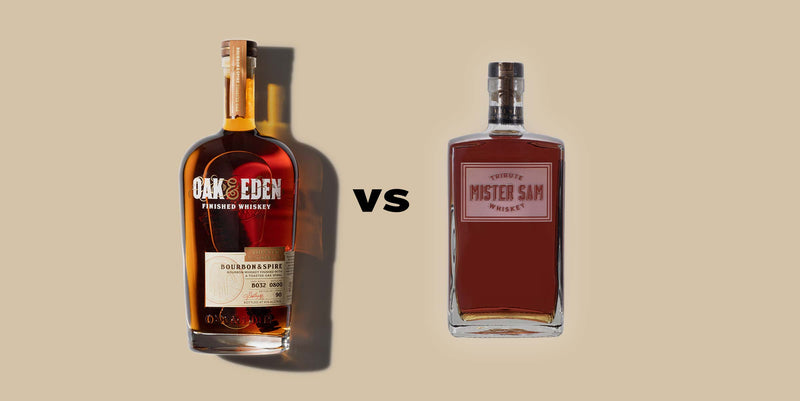
OAK & EDEN VS MISTER SAM TRIBUTE WHISKEY
The world of whiskey offers a fascinating array of flavors and stories, with each brand bringing its own unique approach to this age-old spirit. In this comparative analysis, we explore two distinct brands that stand out in the whiskey market: Oak & Eden and Mister Sam Tribute Whiskey. Each brand exemplifies a unique approach to whiskey making, from innovative techniques to a tribute to whiskey legacy. Let's delve into how these brands differentiate themselves in craftsmanship, flavor profile, and brand ethos.
The Innovator vs The Tribute: Brand Philosophies
Oak & Eden Whiskey represents the forefront of innovation in whiskey production. Renowned for its patented in-bottle finishing technique, Oak & Eden introduces a spiral-cut wood stave into each bottle of whiskey. This method allows the whiskey to continue evolving and maturing right in the bottle, infusing unique flavors and complexities over time. This approach not only showcases our commitment to craftsmanship but also our dedication to creating a dynamic tasting experience for every consumer, even to the degree of allowing our customers the ability to craft their own bottle of whiskey online.
Mister Sam Tribute Whiskey by Sazerac, on the other hand, pays homage to legendary whiskey maker Sam Bronfman, the mind behind some of the most iconic American and Canadian whiskies. This limited-edition blend combines select American and Canadian whiskies, creating a rich, cross-border flavor profile. It's crafted as a tribute to the past, celebrating traditional distilling methods and the historical figures who shaped the industry.
Flavor Profile: Complexity Meets Heritage
Oak & Eden Whiskey offers a range of flavor notes that are continuously enhanced by the wood spire inside each bottle. The interaction between the whiskey and the wood adds layers of vanilla, caramel, and spice, with subtle changes that can be noticed over time. This evolving complexity appeals to those who enjoy experiencing how a whiskey can change and mature, offering a new taste with each sip.
Mister Sam Tribute Whiskey is characterized by its bold, robust flavors typical of both American and Canadian whiskies. Expect notes of toasted oak, vanilla, and spices, with a long, smooth finish that speaks to the expert blending of its components. This whiskey is a nod to traditional flavors that have been beloved by whiskey enthusiasts for decades, crafted to honor a storied past.
Production Techniques: Tradition Meets Innovation
The production techniques of these two brands highlight their philosophical differences.
Oak & Eden’s innovative use of in-bottle wood staves is a modern twist on aging that challenges traditional whiskey maturation practices. This approach allows Oak & Eden to experiment with various types of wood and char levels, tailoring each batch to achieve specific flavor goals.
Mister Sam Tribute Whiskey relies on traditional aging in barrels and the art of blending. By carefully selecting and combining whiskies aged in high-quality barrels, this brand ensures that each batch reflects a consistent, high-caliber flavor profile that honors the legacy of Sam Bronfman. This method relies heavily on the skill of the blender and the quality of the barrels used, emphasizing the artisanal aspect of whiskey crafting.
A Glass for Every Palate
Choosing between Oak & Eden and Mister Sam Tribute Whiskey may come down to personal preference: whether one leans towards innovative approaches that offer a dynamic tasting experience or favors a whiskey that pays respect to traditional distilling heritage with each pour. Oak & Eden caters to those seeking innovation and a hands-on interaction with their whiskey, while Mister Sam Tribute is perfect for those who appreciate the rich history and consistent quality of classic whiskey craftsmanship.
Whichever your preference, both Oak & Eden and Mister Sam Tribute Whiskey offer distinctive experiences that reflect the rich diversity and creativity found in the world of whiskey.
READ THE STORY
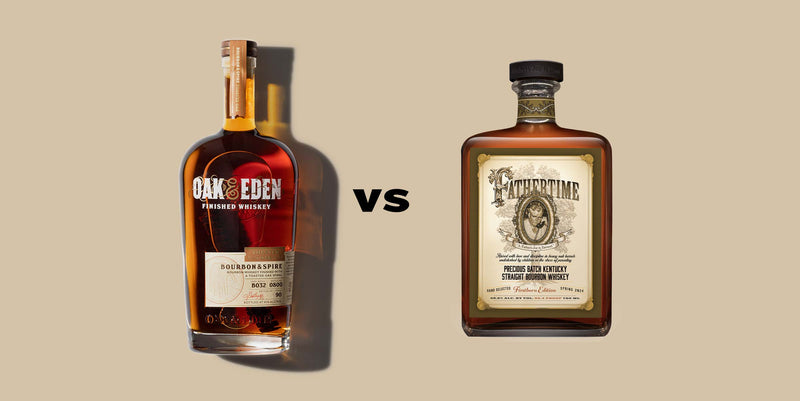
OAK & EDEN VS FATHERTIME BOURBON
In the world of whiskey and bourbon, the arrival of a new brand is always an occasion for excitement and celebration. As pioneers in the whiskey industry, Oak & Eden is pleased to welcome Jim Gaffigan's Fathertime Bourbon into the fold, acknowledging the fresh perspectives and traditional values it brings. This comparative look at Oak & Eden and Fathertime Bourbon not only highlights the unique attributes of each but also underscores the friendly spirit of competition and mutual respect that drives our industry forward.
Introducing Fathertime Bourbon
Fathertime Bourbon, founded by comedian, Jim Gaffigan, is the new kid on the block, bringing with it a commitment to the age-old traditions of bourbon production and a legacy of fatherhood. While Fathertime doesn't yet disclose their distilling or aging standards, the product is bottled at 92.4% proof, promising a depth of flavor that speaks to its artisanal ethos. Jim doesn't call himself a bourbon expert. However, he diligently researched, tasted numerous barrels, and personally chose the bourbon that would be used for Fathertime. He hopes you find as much pleasure in drinking it as he does.
Oak & Eden: Tradition Meets Innovation
At Oak & Eden, innovation is our hallmark. We've revolutionized the whiskey-making process with our patented in-bottle finishing technique, where a spiral-cut piece of wood is introduced into each bottle. This technique allows the whiskey to customize each unique bottle of whiskey for our customers, offering a dynamic taste experience that sets Oak & Eden apart. Our approach reflects a bold departure from convention, designed to intrigue and delight those who seek a new twist on classic flavors.
The Flavor Debate: Tradition vs. Innovation
Fathertime Bourbon – While Fathertime hasn't officially released yet, some of the flavor claims of the product exemplify the classic bourbon experience. It's noted that the flavors are rich and deep, featuring the familiar notes of vanilla, caramel, and oak that bourbon enthusiasts cherish. The lengthy aging process ensures a smooth, refined finish that honors the legacy of bourbon making.
Oak & Eden Whiskey, on the other hand, offers a novel flavor profile that changes subtly over time. The wooden spire imbues our whiskey with a unique complexity, introducing nuances of spice, fruit, and floral notes that traditional barrels alone might not achieve. This innovation not only challenges the palate but also invites whiskey lovers to explore a spectrum of flavors that evolve with each sip.
A Toast to New Beginnings
As we compare Oak & Eden with Father Time Bourbon, we do so with a spirit of camaraderie and a shared passion for quality spirits. We respect the path Fathertime has chosen, rooted in tradition and patience, and we are excited to see how their story unfolds. Meanwhile, Oak & Eden will continue to push the boundaries of whiskey innovation, crafting spirits that surprise and engage our loyal customers.
Thank God for good whiskey
The introduction of Fathertime Bourbon to the market enriches the whiskey community, bringing with it a reminder of the timeless appeal of well-aged bourbon. For those who value the heritage and slow craft of whiskey making, Fathertime offers a pure, unadulterated bourbon experience. Meanwhile, Oak & Eden remains committed to innovation, offering a contemporary twist on the traditional that keeps the spirit of whiskey both ancient and ever-new.
We welcome Fathertime Bourbon with open arms and raised glasses, eager for the friendly exchange of ideas and flavors that will surely benefit all who appreciate fine spirits. Here's to a future where tradition and innovation coexist, each pushing the other to greater heights. Cheers to the rich tapestry of the whiskey industry and to each new chapter that contributes to its storied legacy.
READ THE STORY

CELEBRATING MOTHER'S DAY: A TOAST TO TIMELESSNESS
Mother's Day is a time of reflection, appreciation, and celebration of the women who have shaped our lives. It is a day to honor the enduring love and wisdom of mothers, grandmothers, and maternal figures across the globe. At Oak & Eden Whiskey, we understand the significance of these moments and the memories they create. This Mother's Day, we invite you to celebrate with a tribute to the timeless bond between mothers and their families.
Crafting Memories with Oak & Eden
This Mother's Day, consider how a bottle of Oak & Eden can be more than just a gift; it's a vessel for storytelling and memory-making. Share a glass of our finely crafted whiskey as you recount tales of maternal strength and grace. Each sip is a nod to the past and a toast to the future.
Mother's Day Cocktails: A Mix of Tradition and Innovation
To celebrate, why not mix a special Mother's Day cocktail that encapsulates the warmth and spirit of the occasion? Here are a couple of recipes that use Oak & Eden Whiskey, blending tradition with innovation:
The Maternal Toast: Combine Oak & Eden Rye & Spire with a splash of elderflower liqueur, a dash of lemon juice, and a hint of simple syrup. Serve chilled with a twist of lemon peel for a refreshing drink that's as sweet and complex as motherly love itself.
Timeless Bond: Stir together Oak & Eden Bourbon & Spire, amaretto, and orange bitters. Add ice and garnish with a cherry and orange slice. This cocktail is a robust, flavorful blend that celebrates the enduring and evolving bond shared with mothers.
The Gift of Time
As Father Time ushers in another year, Mother's Day is a poignant reminder to cherish the time we have with our loved ones. Gifting a bottle of Oak & Eden Whiskey is a way to celebrate the moments, both big and small, that define our relationships with our mothers. It's not just whiskey; it's an invitation to create new memories and celebrate the existing ones that we hold dear.
This Mother's Day, let Oak & Eden Whiskey be a part of your celebration. Take a moment to pause and appreciate the timeless moments you share. Raise a glass to the women who have made an indelible mark on your life, and let the rich, nuanced flavors of Oak & Eden inspire stories and memories that transcend time. Just as Father Time is relentless, so is a mother's love—enduring, nurturing, and always evolving.
Here's to the timeless spirits, in our glasses and in our lives. Happy Mother's Day.
READ THE STORY
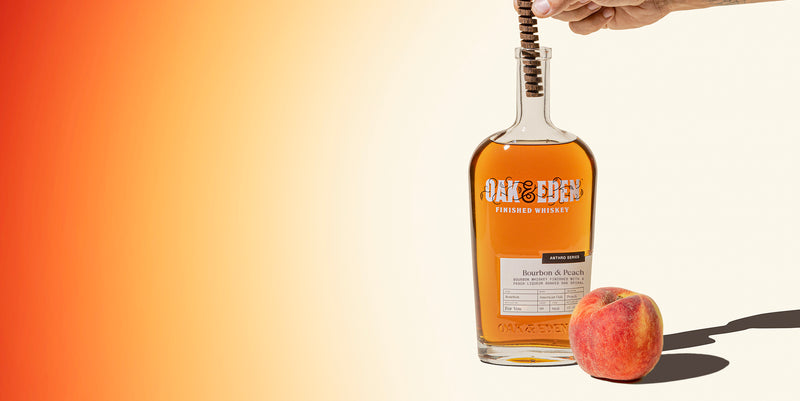
WHISKEY CUSTOMIZER: THE PEACH INFUSION EDITION
Oak & Eden's Whiskey Customizer is a stand out in the innovative world of whiskey. We’ve changed the game, mixed things up, and are proud to share this experience with all who are curious. Whiskey Customizer invites you to curate a whiskey that perfectly aligns with your taste preferences. This experience gives you the opportunity to embark on a personalized journey of whiskey exploration, enabling you to craft your very own custom bottle of whiskey. We released whiskey customizer with four different whiskey bases, two different wood species, and eleven different infusion offerings.You guys asked for more. And we answered. Enter our new peach infusion offering. The perfect flavor for this summertime season. Imagine the velvety sweetness of juicy, ripe peaches merging harmoniously with the smooth burst of liquid gold.Creating your own bottle of whiskey with a peach liqueur finish is a simple yet exciting process. Begin by selecting your base whiskey. Make it barrel strength or keep it 90 proof. Next, choose the wood type — American Oak or French Oak. Then, objectively the best part, is choosing your finishing libation. In this case, we recommend our newest peach liqueur. It introduces a luscious and fruity dimension to your whiskey, elevating the drinking experience with every sip.We invite you to experience the process of building your very own custom bottle of whiskey, pour it neat or mix up a cocktail, savor the rich flavors, and raise your glass to a peachy keen moment! Cheers, y’all!
READ THE STORY
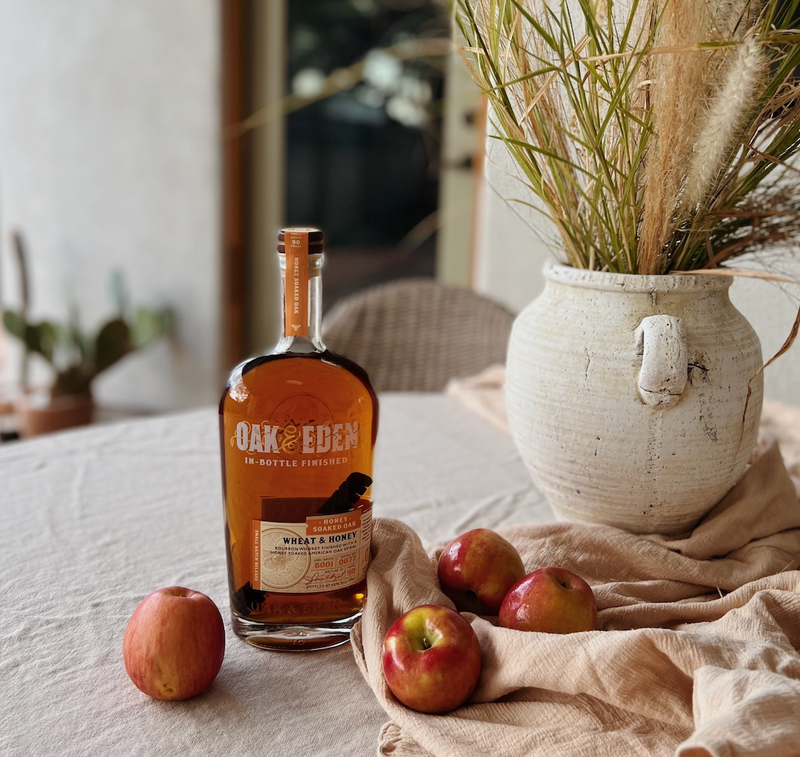
THE SWEATER WEATHER RANCH WATER
The official cocktail of sweater weather - The Gold Coast. Oak & Eden fans are calling it the “sweater weather ranch water.” It's time to put down the Topo + Tequila and pick up Whiskey + Cider!
READ THE STORY
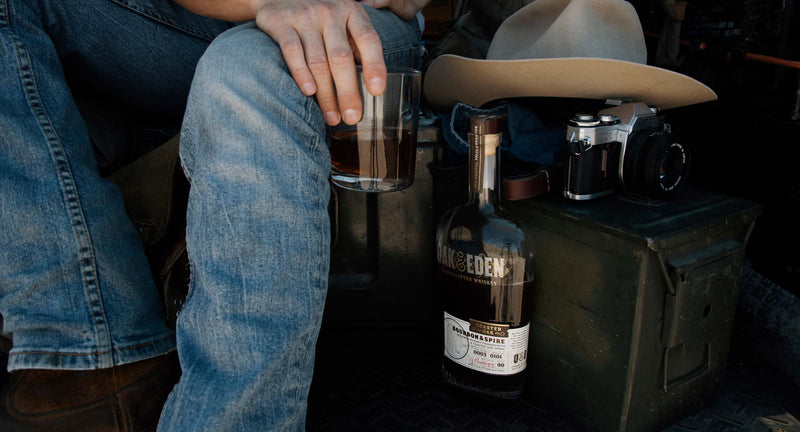
DOES WHISKEY GO BAD? EVERYTHING YOU NEED TO KNOW.
It's a common question asked by whiskey lovers everywhere: does whiskey go bad? The answer, as with most things in life, is – it depends. We get the question often enough, especially with a spire of wood in our bottle, so we figured we'd give you a definitive answer. Here's everything you need to know about whether or not your precious whiskey could go bad.
Whiskey is a distilled spirit made from fermented grain mash. It typically has a high alcohol content, and is aging in wooden casks (usually oak). Because of its high alcohol content, many people believe that whiskey can't go bad. However, this isn't actually the case.
While it's true that the alcohol content in whiskey acts as a preservative, there are still some conditions under which whiskey can go bad. If whiskey is exposed to too much oxygen, for example, it can start to oxidize and develop a rancid taste. Additionally, if whiskey is stored in a hot or humid environment, it can begin to grow mold or mildew.
Another factor to consider is if the bottle has ever been opened. Most of us are familiar with wine oxidizing within the first several hours of a bottle being opened. However, whiskey oxidizes at a much slower rate. It will take years, as opposed to days or hours, for whiskey to develop that sour flavor after being opened. If left unopened, however, a bottle of whiskey can virtually last indefinitely.
One question we often receive at Oak & Eden is "Will the spire ever over-oak the whiskey," or "Will the spire ruin the whiskey after being in the bottle for months or years?" The short answer is no, and here's why. Unlike a barrel, which interacts with oxygen, humidity, barometric pressure, temperature changes, etc. the Oak & Eden spire is fully submerged in a closed glass bottle and often stored in a cool, dark, temperature controlled environment, so once the spire has expressed all of its flavor, it cannot “breathe” the way a barrel would. After about 6 weeks, the spire exhausts and has no flavor left to express. Additionally, because the spire is made of American white oak, a closed-grain wood, and stored in a high proof alcohol, it is impossible to harbor bacteria or mold.
For most of us who store our whiskey in cool, dim environments, however, the spirit will remain perfectly fine to drink for years – even decades. If you're ever concerned that your whiskey has oxidized, or gone bad, the best way to test it before trying it is to give it a smell. If it smells like vinegar, or anything other than whiskey, it's probably best to pour it out. More often than not, it'll be just as delicious as the day you bought it.
READ THE STORY
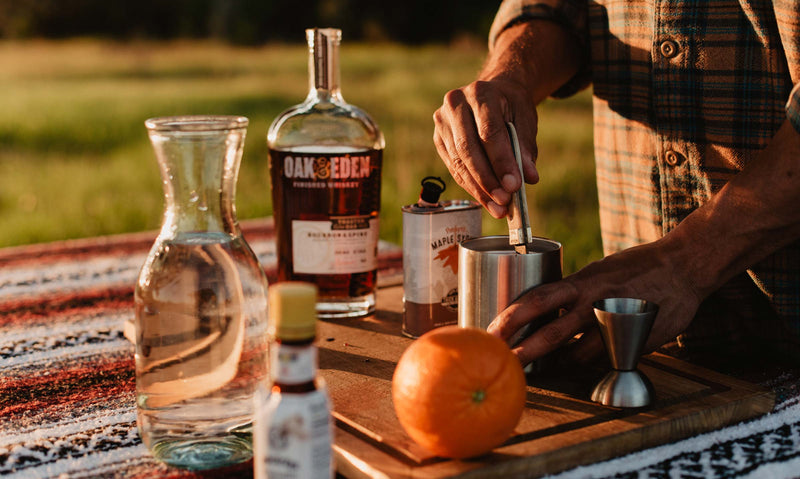
TOP 5 FALL TRANSITIONAL WHISKEY COCKTAILS
We're on our way to saying "So long" to summer and "Hello, fall!" The air is still warm, but the end is in sight and we are beginning to put the refreshers away and break out the bolder, warmer, richer cocktails. Whether you're new to mixing cocktails at home or a seasoned mixologist, we've put together a list of 6 whiskey cocktails we are mixing up that are perfect for the transition from summer to fall.
Coffee Fizz
DIFFICULTY LEVEL: EASY // PREP TIME 3 MINUTES
There’s just something about whiskey and coffee that makes a perfect match. This whiskey cocktail is both refreshing and rich, making it the perfect drink to enjoy as we transition from summer to fall. Whether you’re winding down after a long day or just want to enjoy a unique cocktail, the Coffee Fizz is sure to hit the spot. This simple whiskey cocktail features Oak & Eden's cold brew coffee infused Bourbon & Brew, simple syrup, heavy cream, and soda water. Simple & balanced, it's the ideal whiskey cocktail for any coffee lover.
Click here to see the recipe
Gengine Risk
DIFFICULTY LEVEL: MEDIUM // PREP TIME 6 MINUTES
We all take risks every day, but sometimes it's the calculated ones that pay off the most. Tangy and spicy, this fall transitional whiskey cocktail is an intelligible balance between coastal living and refined luxury. This cocktail features Oak & Eden Rye & Spire, allspice dram, pineapple syrup, lime juice, and chocolate bitters. Perfect for whiskey lovers who enjoy a little bit of everything, the Genuine Risk is a delicious way to transition from summer to fall.
Click here to see the recipe
Mr.Evans
DIFFICULTY LEVEL: MEDIUM // PREP TIME 15 MINUTES
When it comes to whiskey cocktails with complex ingredients, sometimes less is more. A tried and true whiskey cocktail, the Mr. Evans is perfect for summer days that are still warm but with a hint of autumn in the air. For those who can't decide whether they like bourbon or Cabernet better, Mr.Evans is your cocktail. This whiskey cocktail features Oak & Eden's Cabernet infused bourbon, Bourbon & Vine, cabernet syrup, lemon juice, and egg white.
Click here to see the recipe
Espresso Martini
DIFFICULTY LEVEL: EASY // PREP TIME 5 MINUTES
Another coffee cocktail, the Espresso Martini is on the bolder, sweeter side of the spectrum than the Coffee Fizz. The Espresso Martini whiskey cocktail is perfect for those who want to enjoy a delicious dessert and a whiskey cocktail all in one. This whiskey cocktail features Oak & Eden Bourbon & Brew, coffee liqueur, chocolate liqueur, and heavy cream. A delightful way to end any meal or get a little pick-me-up, the Espresso Martini is a must try for whiskey lovers and new whiskey whiskey drinkers alike.
Click here to see the recipe
Old Fashioned
DIFFICULTY LEVEL: EASY // PREP TIME 3 MINUTES
It may seem like a no-brainer, but the Old Fashioned is the whiskey cocktail that typically takes the back burner during the spring and summer seasons. For this reason, it's the perfect whiskey cocktail to transition into fall with. The Old Fashioned whiskey cocktail is simple, bold, and classic. This whiskey cocktail features Oak & Eden Rye & Spire, Angostura bitters, and demerara syrup. If you're looking for a whiskey cocktail that is sure to please, look no further than the Old Fashioned.
Click here to see the recipe
READ THE STORY
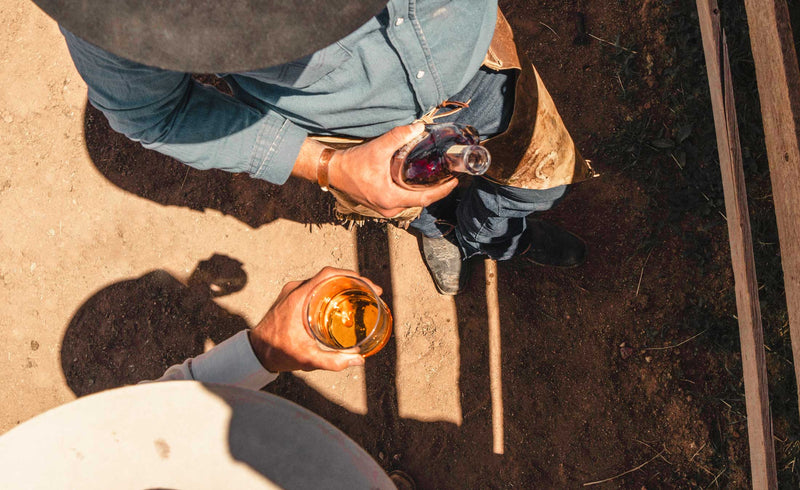
FATHER'S DAY GIFT GUIDE FOR THE BOURBON DAD
Out with neck ties and grilling tools. Dad doesn't want another pair of socks, and he DEFINITELY doesn't need another tie to add to his collection. This Father's Day, get the bourbon dad in your life what he really wants: the perfect essentials for his bar cart and whiskey cabinet. We've taken the guesswork out of gifting with this guide, so you can shop with confidence and find something dad is sure to love.
For the Entertaining Dad
For the bourbon dad who loves to entertain, consider a bar cart that will store all of his bourbon bottles and barware in one place. This way, he can easily roll it out when company comes over and show off his collection.
Buy the Tabiauea Bar Cart
For the Bourbon Loving Dad
Our fan favorite seasonal coffee infused bourbon is a tough one to beat. Winning the highest achievement in the sprits industry – a double gold medal at the San Francisco World Spirits Competition, this bourbon is perfect for the dad who loves a good his coffee as much as he loves his bourbon.
Buy Oak & Eden Bourbon & Brew
For the Recipe Following Dad
Every bourbon dad needs a go-to guide for making his favorite cocktails. This bartending book has everything he needs to know, from how to make classic drinks like the old fashioned to more creative concoctions.
Buy The Bar Tender's Guide Book
For the Home Mixology Dad
This sleek copper bar set is perfect for the bourbon dad who loves mixing drinks. The set includes a shaker, jigger, strainer, and stirrer, so he can make any cocktail his heart desires.
Buy Godinger Copper Bar Tools Set
For the Campfire Drinking Dad
Every bourbon dad needs a good mug to enjoy his favorite bourbon on the rocks. This YETI Rambler mug will keep his drink cold for hours, all the while sipping in style, so he can enjoy it at his leisure.
Buy YETI Rambler Mug
For the Rye Loving Dad
While this list is primarily for bourbon dads, we would be remissed if we didn't include a rye whiskey for the dads who prefer a quality rye. While most rye whiskeys are deep & spicy, Oak & Eden Rye & Spire is uniquely smooth due to the charred American Oak spire placed in the bottle.
Buy Oak & Eden Rye & Spire
READ THE STORY
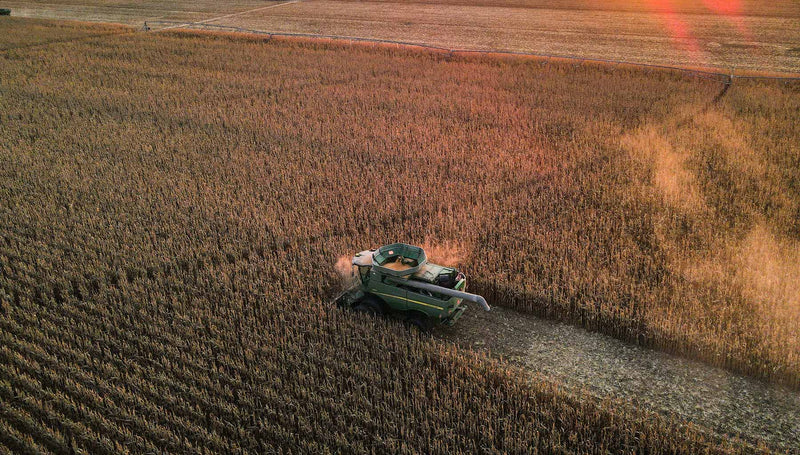
WHAT IS BOURBON MADE FROM?
What Is Bourbon Made From?
Bourbon is the most American of all the liquors and spirits in the world. But is America’s native spirit really any more special than other alcoholic beverages? What is it that makes bourbon special? And what exactly is it made from?
If you want to know what bourbon is made of, you’re in the right place. We’ve compiled all of our bourbon knowledge to give you a complete guide on one of the best kinds of whiskey anywhere in the world.
What Is Whiskey?
Before we dive into bourbon, we need to cover a few basics about whiskey itself. Unlike bourbon, whiskey isn’t a distinctive product of the United States.
There are several different types of whiskey, all of which have unique elements and requirements, but at their core, they all share a few key characteristics. Whiskey is a distilled spirit made from distilled cereal grains, commonly corn, wheat, barley, and rye.
Whiskey is hard liquor and is at least 40% alcohol by volume ( ABV). Whiskey is usually aged in wooden barrels, often for years, before bottling and consumption. Whiskey is anywhere from pale amber to deep brown in color, depending on the aging process and grains used.
What Is Bourbon?
Bourbon is a specific type of whiskey that originated in Bourbon County, Kentucky. Nowadays, straight bourbon can be found anywhere in the United States but must be from Kentucky to be labeled as Kentucky bourbon.
Bourbon must also be made with a sour mash bill of at least 51 percent corn, with the rest being made from a combination of additives which commonly include wheat, malted barley, and rye. This iconic American whiskey has the caramel and vanilla flavor profile that America has grown famous for.
Some of the most popular bourbon producers in the U.S. today include Jim Beam, Maker’s Mark, Four Roses, Town Branch, Buffalo Trace, Wild Turkey, and Woodford Reserve. While Jack Daniels is a renowned Tennessee whiskey, it’s technically not bourbon.
How Is Bourbon Made?
The whiskey-making process is quite varied around the globe, depending on the country of origin and the type of whiskey being made. Bourbon is one of the most highly regulated whiskeys in the world, with the steps of the process closely monitored for quality and consistency across bourbons.
Here is an in-depth look at how the liquor is made at bourbon distilleries and what makes it so delicious.
Step One: Selecting and Mashing the Grains
The first step of the bourbon-making process is the selection of the grains. The mixture of grains used in bourbon is the first of many regulated aspects of the process. All bourbons must be made with a mash bill containing at least 51% corn.
The other 49% of grains can be made up of more corn, rye, barley, or wheat, depending on the specific distillers' recipe. Each distiller tends to have its own specific blends, using grains carefully sourced from around the United States and the world at large for the best and most specific flavor profiles possible.
Once the mash bill is prepared, the grains are ground up very fine and then added to a large vat where it is combined with hot water to create a porridge-like substance, which is called the mash. This whole process is called “mashing” and helps to release the sugars in the grains before fermentation.
Step Two: Fermenting the Grains
The next step of the bourbon-making process is the fermentation and maturation of the grains. This is the process that actually produces the alcohol that is in our favorite spirit.
The mash is placed into a new tub or tank, where yeast is introduced. This yeast then feeds on the sugars that were released during the mashing process, which has the byproduct of producing alcohol.
The fermentation process for straight bourbon whiskey takes anywhere from 48 hours to 96 hours, depending on factors like temperature, humidity, type of grains, and type of yeast used for fermentation. When fermentation is complete, the mash will reach 7-10% ABV, at which point it can be called the distiller’s beer.
Step Four: Distillation
The next, and perhaps one of the most important steps of bourbon production, is distillation. Distillation is the process of purifying and increasing the alcohol content of liquor. Distillation was first invented and used in ancient Mesopotamia to produce aromatics and perfumes.
Distillation has been used in whiskey production for over a thousand years, starting in Ireland and Scotland. Bourbon is produced using the column still distillation method, which is a more modern version of distillation than pot distillation (the older method many other kinds of whiskey used).
In a column distiller, the distiller feeds the distillers beer into the column, where it is heated to boiling by the infusion of hot water vapor. This causes the alcohol to vaporize, rising through the column until it hits the first condenser plate.
The condenser plates are metal plates in the column still that alternate up the height of the column. When the alcohol vapors reach the plates, they condense back into liquid. From here, the vapors are redistilled in a pot called a doubler. Then the rising hot water vapor heats the condensed liquid back into vapor, where it rises to the next plate to repeat the process.
Eventually, the gasses are captured and funneled into the condenser still where the spirit is brought back to its liquid state at around 70% ABV.
Step Five: Aging
From the column still, the spirit then goes into new, charred white oak barrels to be aged for a minimum of two years. The charred new oak casks give bourbon its distinct vanilla notes and sweetness. Using these oak containers is one of the legal requirements for a spirit to be labeled bourbon.
As the whiskey rests in the wooden barrels, the porous wood adds its flavors and aromas to the wood. Over time, this works to purify the whiskey, remove the harsh flavors, and add new and exciting elements to the flavor profile.
If you’re ever wondering how old a specific bottle of bourbon is, you’ll find an age statement on the label. In general, the older the bottle, the rarer it is.
Step Six: Bottling
Once the whiskey has finished aging, it is ready to be bottled and sold for consumption. Many distillers will mix many barrels of whiskey together before bottling to create uniformity. If a bottle of whiskey contains only whiskey that was aged in one barrel together, then that is called a single barrel whiskey.
Step Seven: In-Bottle Finishing
For most whiskeys and bourbons, the whiskey-making process is complete. But at Oak & Eden, we take things one step further. We use a technology we call in-bottle finishing to add flavors and finishing notes to our whiskey while it sits in its bottle waiting for you to drink.
In every bottle of Oak & Eden whiskey, you will find our patented wooden spires: spiral-cut pieces of wood designed for maximum surface area. These spores are selected, spiced, and prepared precisely for each different blend of Oak & Eden Whiskey to give each bottle and blend the perfect finishing touch.
So What Is Bourbon Made From?
Now that we understand what exactly goes into the bourbon-making process, we can understand a little bit clearer what bourbon is actually made from.
First and foremost, bourbon is made from grains, of which at least 51% needs to be corn. The other grains used can be any combination of barley, rye, or wheat. Bourbon must also be made using column distillation instead of pot distillation, another distillation technique used for other whiskies, like Scotch.
And finally, bourbon must be aged in new oak barrels with char on the inside. While you may not consider the barrel an important ingredient in the bourbon, we certainly do. The wood that whiskey is aged in is where most of the flavor and all of the color of whiskey come from. This means that, by some counts, the barrel is the most important ingredient in any whiskey, not just bourbon.
Is Bourbon More Special Than Other Varieties of Whiskey?
All this commotion about bourbon whiskey may have you starting to feel that bourbon is the pinnacle of whiskey and no other whiskey could compare. But bourbon is just one of the many regional varieties of whiskey throughout the globe.
While bourbon has seen a bit of a global resurgence in recent decades, there are great whiskeys made across all varieties and in all regions of the globe. From smoky Scotch to smooth Irish whiskey, there are plenty of whiskey blends and options for all tastes and flavors.
Here at Oak & Eden, we offer a variety of whiskeys, including bourbon, rye, and wheat whiskey. We also offer some special blends that combine our whiskey with flavors of cold brew coffee and more.
You can learn more about our story and our whiskey here.
What Is Bourbon Made From: Takeaways
Bourbon is the most famous American-made whiskey in the world and is notorious for its balanced, sweet, and warm flavor profile. There are a lot of distinctions that make bourbon unique that all bourbons must meet to legally call themselves bourbon.
Bourbon whiskey must be made with a mash bill of at least 51% corn. Then the whiskey must be made in the United States and distilled using column distillation. From there, the whiskey must be aged in new, charred oak barrels for a minimum of two years before bottling and consumption.
Oak & Eden Whiskey goes through an extra step, which is in-bottle finishing. Our carefully crafted wooden spires add subtle flavor notes to our fully aged whiskeys while they are in the bottle waiting for you to drink. This gives our whiskeys their creamy, smooth, and complex flavors.
Give Oak & Eden whiskey a try and see what difference the spire makes.
Sources:
Coffey still | Whisky Advocate
What is Kentucky Bourbon Whiskey? | BourbonCountry
What's the Difference Between Bourbon and Whiskey? | Food & Wine
READ THE STORY
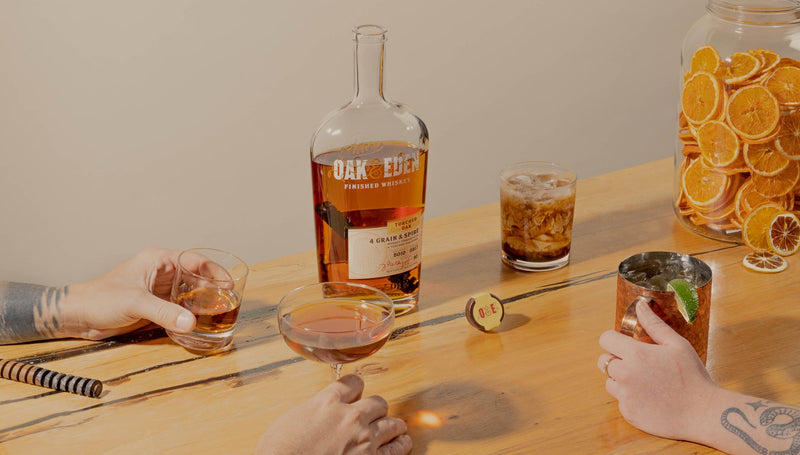
WHAT IS WHISKEY? WHAT YOU SHOULD KNOW
What Is Whiskey? What You Should Know
There are usually a few bottles of different whiskeys from different distilleries at every bar.
Whiskey is one of the five core liquors — vodka, gin, rum, tequila, and whiskey — which are the most popular liquors globally. But beyond that, do you really know what whiskey is? Sure, it’s alcohol, but what’s in it?
Whether you have never had a sip of whiskey in your life and are looking to get into it, or you are a seasoned whiskey sipping expert, you might be surprised just how much about whiskey you didn’t know.
Here are a couple of the essential facts about whiskey that you should know to best enjoy this delicious spirit.
Whiskey: The Basics
There are dozens of different varieties of whiskey that are all distinct regional creations that have unique tastes, flavors, production techniques, and histories. A few examples of common whiskey nomenclature include:
Single-malt whiskey or single distillery whiskey
Canadian whiskey
Scottish whisky (Scotch)
American whiskey (Bourbon)
Irish Whiskey
Corn whiskey
Whiskey from Japan
Whiskey cocktails like an old fashioned or whiskey sour
At its core, however, there are some things that all whiskey types share, no matter where they came from.
Whiskey is an amber to the brown-colored distilled spirit made from fermented grains of varying blends and varieties depending on local grains and tastes. This mash of cereal grains often includes some corn. Whiskey is hard liquor and usually has an alcohol content of about 40% ABV.
It’s typically distilled and then aged in wooden casks for some time before they are eventually bottled. This aging process is a major component of the flavors of each specific different kind of whiskey.
Each whiskey is unique in flavor, but common flavor notes across varieties of whiskey are warm, spicy, caramelly, nutty, woody, and toasty.
When Was Whiskey Invented?
The origin of whiskey holds plenty of its own clues about what whiskey has to offer and the flavors of whiskey around the globe.
The story of whiskey all starts with the discovery of the distillation process, which through the use of alternated boiling and condensation, produces a stronger alcoholic product. Distillation was first used in Mesopotamia as far back as 2000 B.C, making it over 4000 years old.
Distillation slowly spread throughout Greece and then Europe, where the process was used to distill everything from aromatics to drinking water to alcoholic beverages.
The first time that we see whiskey coming up is in the 1000s A.D., when monks in Scotland, unable to ferment alcoholic beverages from grapes, began fermenting grain mashes that would be distilled to become the first whiskies.
Whiskey was originally referred to as aqua vitae, Latin for the water of life, which eventually became known as whiskey. Distilleries became quite successful in Ireland and Scotland, and as Europeans immigrated to the United States, distilleries came with them.
Eventually, this led to the proliferation of distilleries in Kentucky and Tennessee, which produce some of the world's finest bourbons, ryes, and Tennessee whiskies.
What Are the Different Kinds of Whiskey?
There are many different kinds of whiskey, each with its own unique requirements, ingredients, styles, and flavors. Here is a little overview of what each kind of whiskey is.
Bourbon Whiskey
Bourbon is a type of whiskey that is uniquely American. There are several things that make a bourbon a bourbon, but first and foremost, all bourbon has to be made in the United States.
Rye Whiskey
Rye whiskey, unlike bourbon whiskey, does not have to be made in the United States of America. In fact, rye whiskey is very popular in Canada in addition to the United States. Rye whiskey uses a mash bill of at least 51% rye. This gives rye its distinctive, spicy flavor profile that people love.
Tennessee Whiskey
Tennessee whiskey is much like bourbon whiskey, except Tennessee whiskey must be made in the state of Tennessee. Tennessee whiskey must use a Maysville with at least 51% corn and must also go through a special charcoal maturation process that mellows the flavors in the whiskey.
A prime example of this type of whiskey is Jack Daniel’s.
Scotch Whisky
Scotland was one of the first places in the world to produce whiskey.
Scotch whiskies are typically malt whiskies, meaning they are made using mostly malted barley in the mash bill. Scotch whiskies must also be made in Scotland as well as be aged for a minimum of three years also in Scotland.
Irish Whiskey
Jameson is the most famous of the Irish whiskies around the globe, and while they may be similar to Scotch, they are distinct. Irish whiskey, also known as Gaelic whiskey, is made with barley (typically unmalted). This gives Irish whiskey its smoothness and removes some of the smokiness that Scotch whiskey is famous for.
Japanese Whisky
Japanese whisky is a newcomer to the global whisky world, and it is spelled without the “e,” just like Scotch. Japanese whisky is based on Scotch, using manly malted barley, often imported from Scotland.
Japanese whisky uses the same distillation method as Scotch and is then aged in American wood, Japanese wood, or Sherry casks, which give Japanese whiskey its unique flavors like citrus and incense.
How Is Whiskey Made?
The process of whiskey is a long and complicated process, but one that takes us from simple grains to one of the finest beverages in the world. Here is an inside look at each step of the process one by one.
Pickling and Fermenting the Grains
Every great whiskey starts with different types of grains like wheat, barley, corn, and rye, which are carefully selected and combined in precise proportions to create the fermented mash bill, the recipe for the grains.
These grains then have to be mashed for them to release the sugars, which is done by grinding the grains and combining them with hot water in a tank and then stirring and mixing. Once the grains have released their sugars, and the mixture has thickened, it is ready for fermentation.
In a fermentation tank, yeast is introduced to the mash, which is then left to ferment for a few days before it is ready to move on. The fermentation process depends on the strain of yeast and the grains used.
After the fermentation period is over, the distiller has a beer-like liquid between 7-10% ABV, often referred to as distillers beer.
The Distillation Process
Now the fermented grain mash liquid or distilled beer is ready for the distillation process. The distillation process is used to increase the volume of alcohol in something. There are a few different distillation methods, but all are based on evaporating and condensing liquids to remove impurities and unwanted items.
Pot Still Distillation
Pot still distillation is one of the popular whiskey-making methods for malt whiskeys, which are whiskies made with malted barley. The malting process replaces the mashing process for malted whiskies. But Bourbons and other grain whiskies do not go through pot distillation.
In a post still, the distiller's beer is put in a still, a large metal pot, where it is heated to boil. Since alcohol has a lower boiling point than water, it evaporates quickly, and the gasses that rise off the boiling distiller's beer rise up into a tube that carries this gas into the second still, where it is condensed back into a liquid.
The resulting liquid comes out at about 20% ABV, so the process is then repeated two more times to reach a final product that is typically around 60-70% ABV.
Column Distillation
Column distillation is the other common distillation process for whiskies and is the primary process for grain whiskies like bourbon, rye, and corn whiskies. Unlike pot stills which have to go through a batch process, column stills work continuously to the final product.
The distiller’s mash is fed into the column still, where it is heated with hot water vapor, which causes the alcohol vapors to rise up the column. As the vapor rises, it repeatedly hits alternating metal plates in the column, which condense the vapors.
Then, the rising steam, which is still being fed through the column, heats the liquid again, as it constantly condenses and evaporates over and over up the column, where it eventually reaches a tube connecting it to the condenser which leaves the final distilled spirit.
Column stills are capable of very high distillation percentages, as high as 95%, although when distilling alcohol for consumption, they are not usually set to go that high.
The Aging Process of Whiskey
After distillation has been completed, the longest step of the process comes into play: aging. Much of whiskey's color, flavor, and aroma comes from the aging process rather than the distillation process.
The aging process is where many of the rules and regulations surrounding different designations of whiskey are located. For bourbon, rye, and other American whiskies, the rules stipulate the use of new, charred oak barrels for the aging process.
In other countries and styles, different distillers may use different woods and barrels that have previously been used for other purposes to create distinct flavor profiles and aromas for their own tastes.
During the aging process, the wood is porous and imparts its flavor profiles, terpenes, and oils into the liquid, giving it both color and flavor.
The Bottling Process of Whiskey
From there, your favorite whiskey is then bottled with at least 40% ABV and sealed for consumption later. Depending on the distiller and the run of whiskey, several barrels are usually combined in one bottling.
If only a single barrel is used in a bottle, then it is labeled as a single barrel or single cask whiskey.
What Is Finished Whiskey?
Many whiskeys are aged in just one barrel over the duration of the aging product. But other whiskies change barrels during the aging process, where the whiskey is “finished” with flavors from another wood.
Finished whiskey is a way that distillers can add additional flavors and elements to their whiskies, depending on what flavor profile they want the whiskey to have. These finished whiskies can be more complex and varied than traditional single-barrel whiskey.
What Is In-Bottle Finishing?
In most whiskies, bottling is the final step of whiskey production, and from here, the bottle is sold and consumed. But for Oak & Eden whiskey, the process isn’t quite finished. We use a process that we invented called in-bottle finishing.
In every bottle of Oak & Whiskey, you will find one of our specially designed wooden spires, designed for maximum surface area. This spire continues to flavor and finish your whiskey in the bottle, so it continues to improve and develop new flavors as it continues to rest in the bottle.
Unlike a second barrel finishing, our in-bottle process allows the whiskey to receive its finishing notes in the bottle itself. The longer you have the bottle, the longer the flavors of the spire will have to infuse the whiskey with the subtle flavor notes that Oak & Eden whiskies offer.
What Is Whiskey? The Takeaways
Whiskey is a varied and diverse spirit with many different varieties and regional tastes and flavors that go into them. At its core, whiskey is a distilled grain spirit, typically made from corn, barley, wheat, and rye, which is then aged in wooden barrels.
Whiskey is noted for its caramel and vanilla notes and flavors, as well as the woody and warm flavors common in whiskey. Whiskey is made through a process beginning with selecting the grain mash, fermenting the grains, distilling, and then aging and bottling the spirit when it is complete.
There are many different specific types of regional whiskey styles, from bourbon whiskey, rye whiskey, Irish whiskey, Scotch whisky, Japanese whisky, and Tennessee whiskey.
Oak & Eden offers bourbon, rye, and wheat whiskies that you are bound to love. Our whiskies use a technique called in-bottle finishing to get the finest flavors and aromas out of your whiskey. If you have never tried a finished whiskey before, we promise you are going to love it.
Sources:
Japanese Whisky: The Origin Story | Whiskey Culture
Coffey still | Whisky Advocate
What is Kentucky Bourbon Whiskey? | Bourbon Country
READ THE STORY
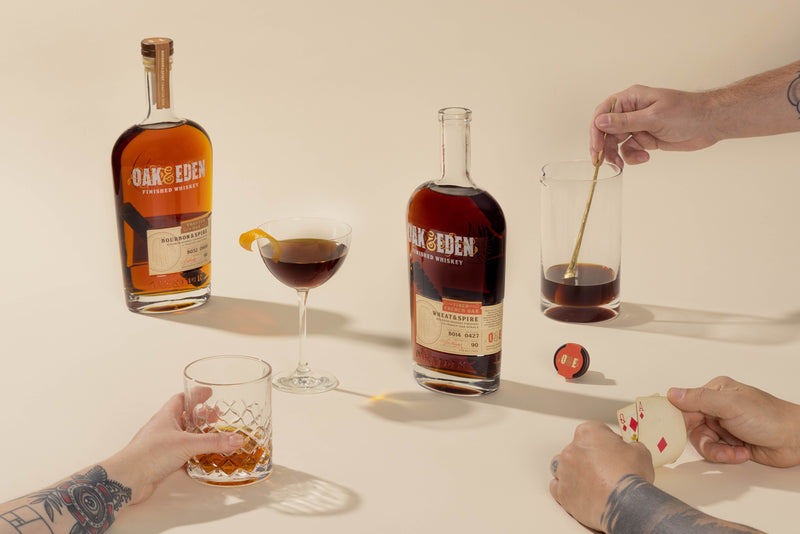
WHAT IS WHISKEY MADE OF?
The next time you’re at the bar, consider gravitating towards the smoky, dark, and intense bite of whiskey. Whether you choose to sample this liquor on its own or indulge in a mint julep, a Manhattan, or an old fashioned, it promises to be simple, classic, and delicious.
READ THE STORY
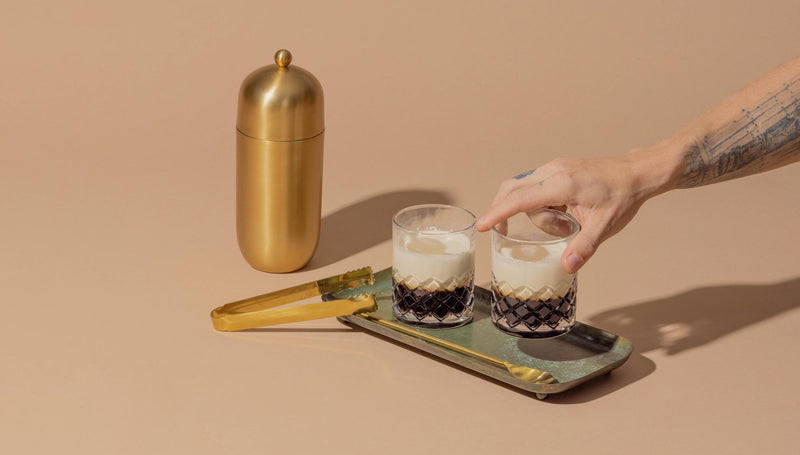
WHAT TO MIX WITH BOURBON: 9 CREATIVE IDEAS TO TRY
Whiskey drinkers around the globe have enjoyed bourbon for nearly two centuries. Known for its trademark dark flavor profile, this coveted liquid leaves an impression on even the most experienced drinkers.
READ THE STORY
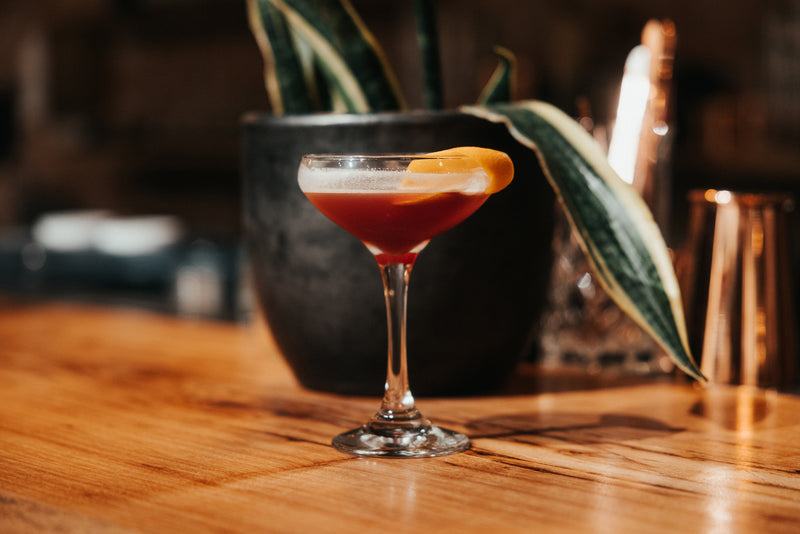
HOW TO DRINK BOURBON: ULTIMATE BEGINNERS GUIDE
Every year, bourbon becomes increasingly more popular among new drinkers. It’s showing up with greater frequency on cocktail menus worldwide, as well as an option to drink on its own.
READ THE STORY
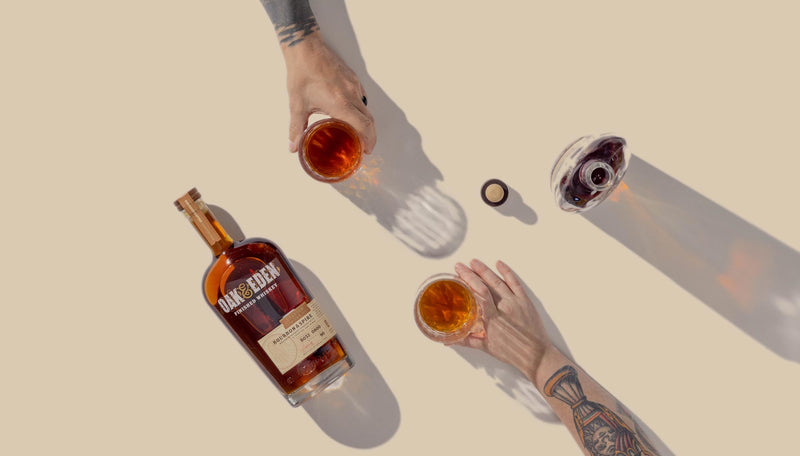
WHISKEY VS. BOURBON: WHAT TO KNOW
Bourbon whiskey is the most famous type of whiskey in the United States of America. As the most famous spirit to come out of distilleries in the US, bourbon carries a heavyweight as the world's liquor ambassador of the United States.
READ THE STORY
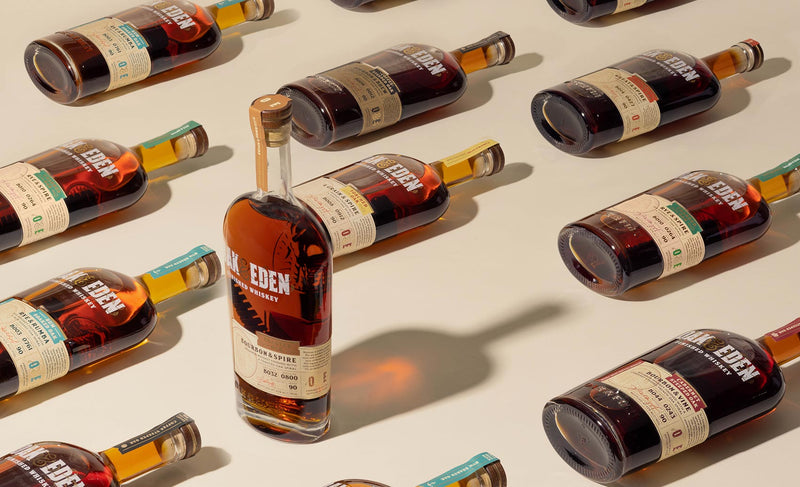
WHAT IS BOURBON? COMPLETE GUIDE
Bourbon whiskey is an American whiskey that has been enjoyed for generations. Cowboys, musicians, and bargoers alike have all rallied behind this timeless smoky drink.
READ THE STORY
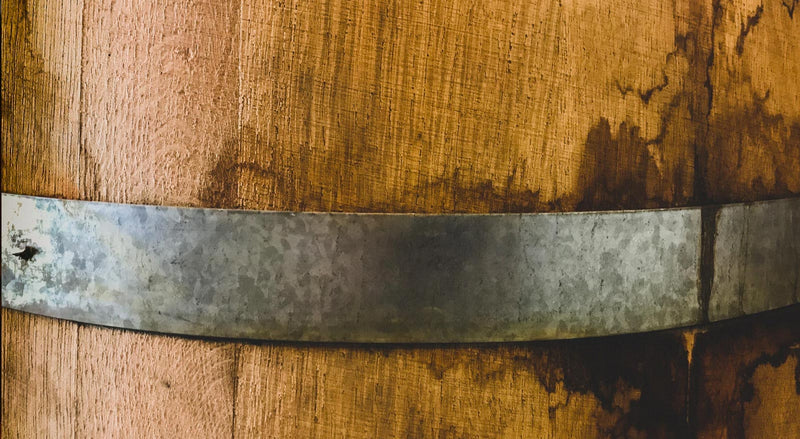
ANGEL’S SHARE WHISKEY: WHAT IS IT?
The angel’s share is the whiskey lost to evaporation during the aging process. It’s an inevitable part of making whiskey.
READ THE STORY
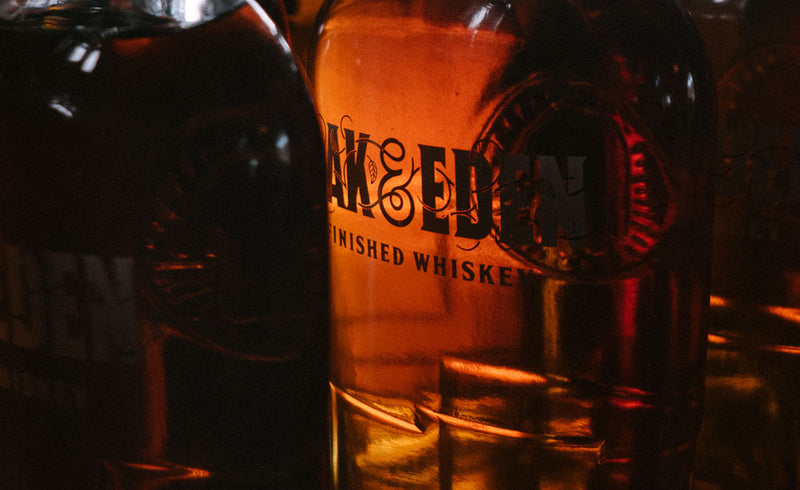
WHAT IS SINGLE BARREL BOURBON?
Bourbon is one of the most delicious drinks on the planet. Classic on the rocks, straight up, or as the main ingredient of a cocktail, bourbon is the quintessential American spirit.
READ THE STORY
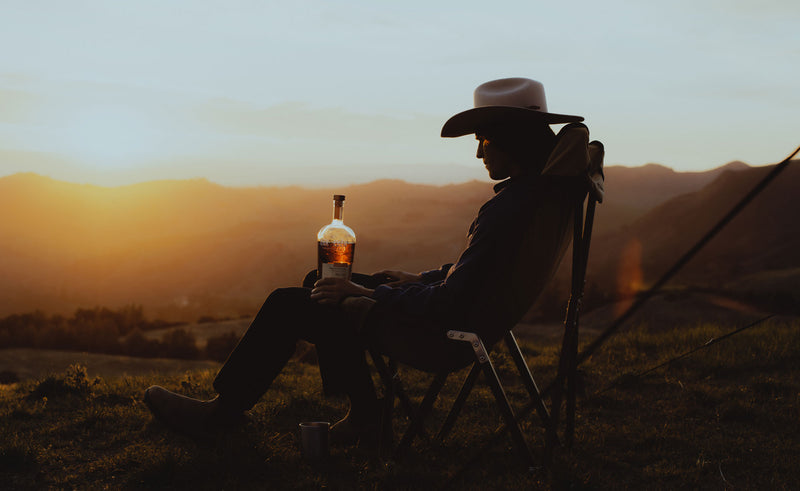
WHISKEY VS. SCOTCH: WHAT YOU SHOULD KNOW
Whiskey brings people together to laugh, tell stories, and share good times, whether at the bar or in the comfort of their homes.
READ THE STORY
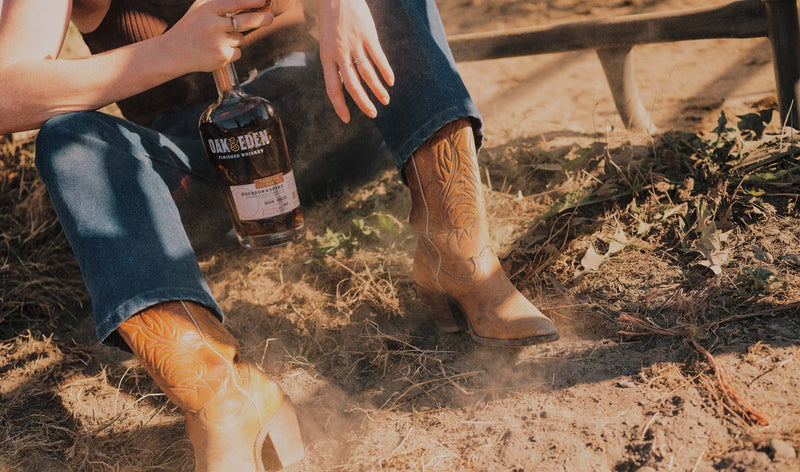
BOURBON VS. COGNAC: WHAT YOU SHOULD KNOW
Bourbon and Cognac are two of the most popular distilled spirits in the world. Both are well-known for their aging processes, which impart the rich and subtle flavors that make them unique.
READ THE STORY
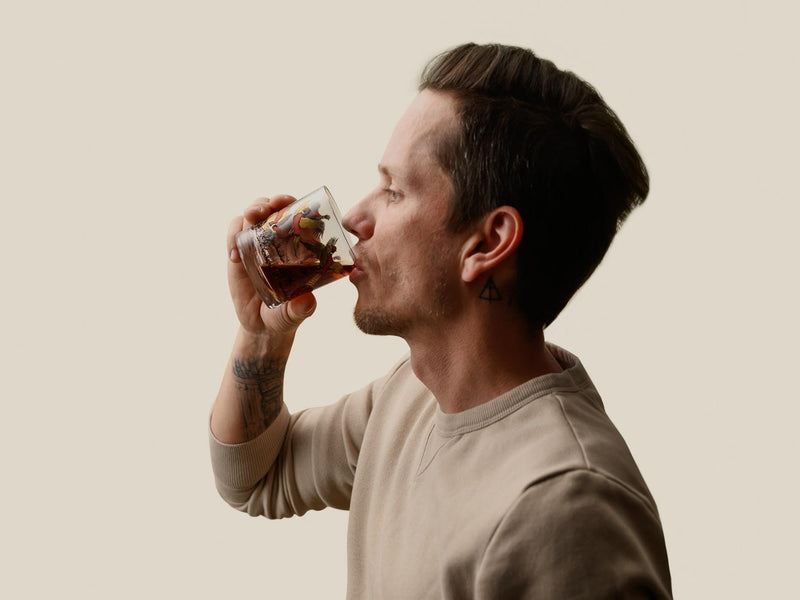
WHISKEY: THE HEALTHIEST SPIRIT ON EARTH?
Whiskey is no stranger to the health conscious, but what is it exactly that gives it this healthy reputation?
READ THE STORY
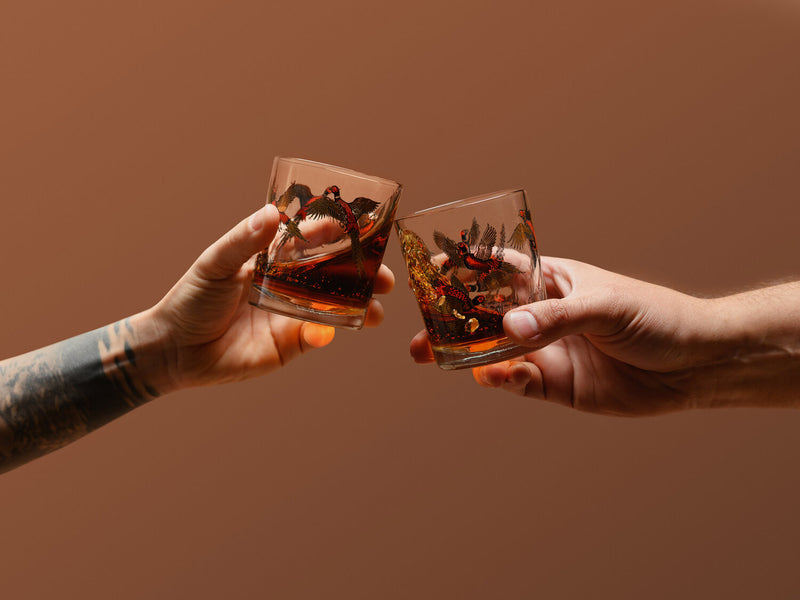
WHISKEY OR WHISKY: WHAT’S THE DIFFERENCE?
Whiskey or whisky? What’s the difference? Is it simply two different spellings of the same word, or are they two slightly different words describing two separate groups of spirits?
READ THE STORY
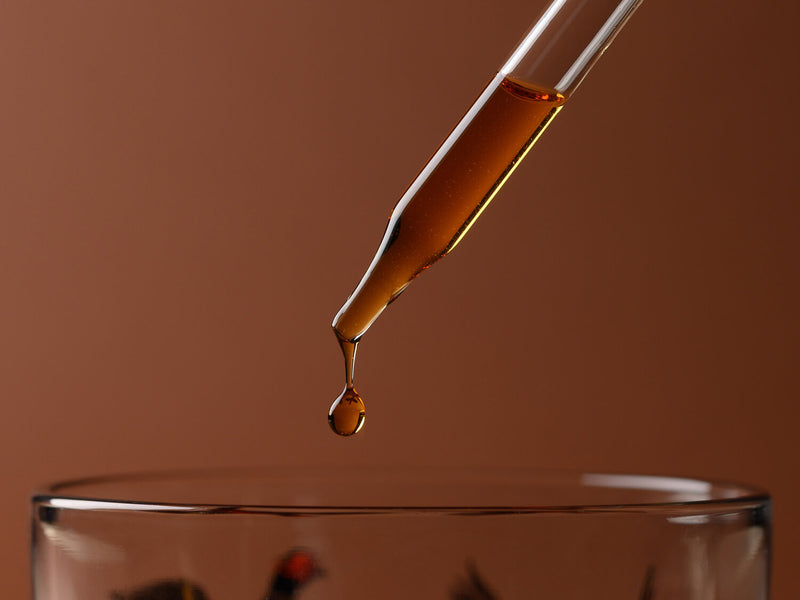
BITTERS 101
Bitters are made from botanicals, like aromatic herbs, roots, fruit, and bark. These ingredients are infused into a flavorless alcohol base to create a potent flavoring.
READ THE STORY

